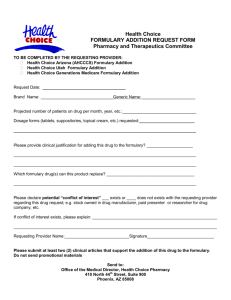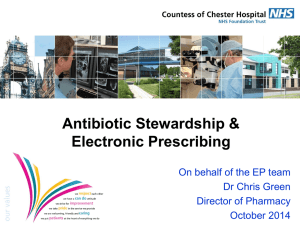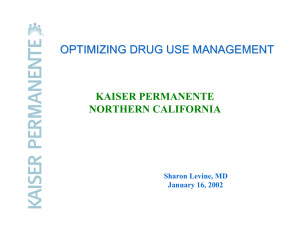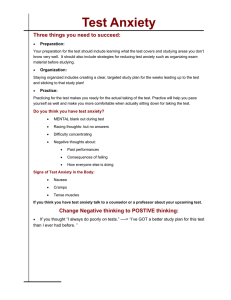Document 13308475
advertisement
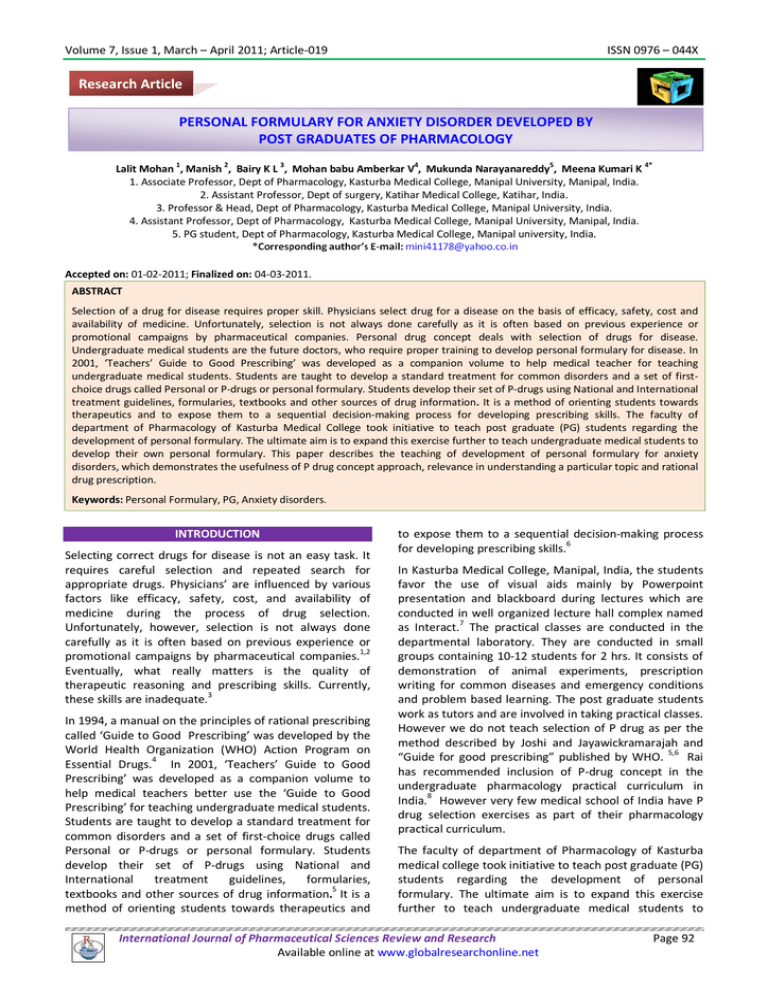
Volume 7, Issue 1, March – April 2011; Article-019 ISSN 0976 – 044X Research Article PERSONAL FORMULARY FOR ANXIETY DISORDER DEVELOPED BY POST GRADUATES OF PHARMACOLOGY 1 2 3 4 5 Lalit Mohan , Manish , Bairy K L , Mohan babu Amberkar V , Mukunda Narayanareddy , Meena Kumari K 1. Associate Professor, Dept of Pharmacology, Kasturba Medical College, Manipal University, Manipal, India. 2. Assistant Professor, Dept of surgery, Katihar Medical College, Katihar, India. 3. Professor & Head, Dept of Pharmacology, Kasturba Medical College, Manipal University, India. 4. Assistant Professor, Dept of Pharmacology, Kasturba Medical College, Manipal University, Manipal, India. 5. PG student, Dept of Pharmacology, Kasturba Medical College, Manipal university, India. 4* Accepted on: 01-02-2011; Finalized on: 04-03-2011. ABSTRACT Selection of a drug for disease requires proper skill. Physicians select drug for a disease on the basis of efficacy, safety, cost and availability of medicine. Unfortunately, selection is not always done carefully as it is often based on previous experience or promotional campaigns by pharmaceutical companies. Personal drug concept deals with selection of drugs for disease. Undergraduate medical students are the future doctors, who require proper training to develop personal formulary for disease. In 2001, ‘Teachers’ Guide to Good Prescribing’ was developed as a companion volume to help medical teacher for teaching undergraduate medical students. Students are taught to develop a standard treatment for common disorders and a set of firstchoice drugs called Personal or P-drugs or personal formulary. Students develop their set of P-drugs using National and International treatment guidelines, formularies, textbooks and other sources of drug information. It is a method of orienting students towards therapeutics and to expose them to a sequential decision-making process for developing prescribing skills. The faculty of department of Pharmacology of Kasturba Medical College took initiative to teach post graduate (PG) students regarding the development of personal formulary. The ultimate aim is to expand this exercise further to teach undergraduate medical students to develop their own personal formulary. This paper describes the teaching of development of personal formulary for anxiety disorders, which demonstrates the usefulness of P drug concept approach, relevance in understanding a particular topic and rational drug prescription. Keywords: Personal Formulary, PG, Anxiety disorders. INTRODUCTION Selecting correct drugs for disease is not an easy task. It requires careful selection and repeated search for appropriate drugs. Physicians’ are influenced by various factors like efficacy, safety, cost, and availability of medicine during the process of drug selection. Unfortunately, however, selection is not always done carefully as it is often based on previous experience or promotional campaigns by pharmaceutical companies.1,2 Eventually, what really matters is the quality of therapeutic reasoning and prescribing skills. Currently, these skills are inadequate.3 In 1994, a manual on the principles of rational prescribing called ‘Guide to Good Prescribing’ was developed by the World Health Organization (WHO) Action Program on 4 Essential Drugs. In 2001, ‘Teachers’ Guide to Good Prescribing’ was developed as a companion volume to help medical teachers better use the ‘Guide to Good Prescribing’ for teaching undergraduate medical students. Students are taught to develop a standard treatment for common disorders and a set of first-choice drugs called Personal or P-drugs or personal formulary. Students develop their set of P-drugs using National and International treatment guidelines, formularies, textbooks and other sources of drug information.5 It is a method of orienting students towards therapeutics and to expose them to a sequential decision-making process for developing prescribing skills.6 In Kasturba Medical College, Manipal, India, the students favor the use of visual aids mainly by Powerpoint presentation and blackboard during lectures which are conducted in well organized lecture hall complex named as Interact.7 The practical classes are conducted in the departmental laboratory. They are conducted in small groups containing 10-12 students for 2 hrs. It consists of demonstration of animal experiments, prescription writing for common diseases and emergency conditions and problem based learning. The post graduate students work as tutors and are involved in taking practical classes. However we do not teach selection of P drug as per the method described by Joshi and Jayawickramarajah and 5,6 “Guide for good prescribing” published by WHO. Rai has recommended inclusion of P-drug concept in the undergraduate pharmacology practical curriculum in India.8 However very few medical school of India have P drug selection exercises as part of their pharmacology practical curriculum. The faculty of department of Pharmacology of Kasturba medical college took initiative to teach post graduate (PG) students regarding the development of personal formulary. The ultimate aim is to expand this exercise further to teach undergraduate medical students to International Journal of Pharmaceutical Sciences Review and Research Available online at www.globalresearchonline.net Page 92 Volume 7, Issue 1, March – April 2011; Article-019 ISSN 0976 – 044X develop their own personal formulary. This paper describes the teaching of development of personal formulary for anxiety disorders, which demonstrates the usefulness of P drug concept approach, relevance in understanding a particular topic and rational drug prescription. It also brings in focus the utility of P drug concept in prescription writing. genders. The PG students carried out the exercise in their groups using Current Index of Medical Specialities (CIMS) to determine cost of drugs9 and they also used textbooks and reference materials available in the college and departmental library for other criteria. RESULTS Eleven PG students of the department of pharmacology participated in this study to develop personal formulary for anxiety disorders. The study was divided into two parts; first part is teaching of the P drug concept and second part to develop personal formulary for anxiety disorder. MATERIALS AND METHODS The study was carried out among the PG medical students at Kasturba Medical College, Manipal, during the month of June 2010, after the permission from Head of department of pharmacology to develop personal formulary for anxiety disorder. Kasturba medical college, Manipal admits four PG students who are medical graduates and the course duration is of three years. Three batches containing 11 students out of 12 PG students were taught P drug concept and then they took part in development of personal formulary for anxiety disorder. They were taught for 1 hour regarding P-drug concept as per Joshi and Jayawickramarajah.6 The three practical batches were made for next session for three hours to develop personal formulary for anxiety disorders. The admixture was done on the basis of year of admission, and gender, each batch having 3 or 4 students of both In this study personal formulary was developed by using parameters like efficacy, safety, cost and convenience (Joshi and Jayawickramaraja).6 The benzodiazepines as a group was chosen (Table 1) and among this group individual drug alprazolam emerged as Personal formulary for anxiety disorders (Table 2). The cost comparison of drugs was done by using CIMS (Table 3). The personal formulary was developed for the P-drug alprazolam as a practical elaboration of the P-drug concept, which is shown in (Table 4). Table 1: Selection of personal formulary from drug group for anxiety disorders Drug/drug group Benzodiazepines Azapirones Sedatives Antihistaminics β blocker SSRIs Efficacy (0.4) 8 (3.2) 5 (2.0) 4 (1.6) 3 (1.2) 7(2.8) Safety (0.3) 6 (1.8) 8 (2.4) 6 (1.8) 5 (1.5) 6(1.8) Cost (0.2) 8(1.6) 7 (1.4) 6 (1.2) 7 (1.4) 5(1.0) Convenience (0.1) 6 (0.6) 5 (0.3) 5 (0.5) 6 (0.6) 8 (0.8) Total 7.2 6.1 4.5 4.8 6.4 Table 2: Selection of personal drug among benzodiazepines for anxiety disorders Drug/drug group Alprazolam Diazepam Lorazepam Oxazepam Efficacy (0.4) 8 (3.2) 7 (2.8) 6 (2.4) 6(2.4) Safety (0.3) 8 (2.4) 6 (1.8) 7 (2.1) 8 (2.4) Cost (0.2) 5(1.0) 8(1.6) 8(1.6) 7 (1.4) Convenience (0.1) 7 (0.7) 8 (0.8) 6 (0.6) 6 (0.6) Total 7.3 7.0 6.7 6.8 Table 3: Cost of drugs/drug group available in India used in treatment of anxiety disorders Drug/Drug group 1.Benzodiazipines a. Diazepam b. Chlordiazepoxide c. Oxazepam d. Lorazepam e. Alprazolam 2. Azapirones Buspirone 3. Sedative antihistaminic Hydroxyzine 4. β-blokers Propranolol 5. SSRIs a. Fluoxetine b. Escitalopram c. Paroxeteine Dose range No. of brands Range of lowest dose cost of tab/day(INR) Average cost of lowest dose, tab/30days (INR) 5 to 30mg 20 to 100mg 30 to 60mg 1 to 6mg 0.25 to 1mg (TDS) 6 3 1 13 51 0.29 to 2.52 3.00 to 5.80 1.656 0.75 to 1.85 1.53 to 5.58 40.50 91.50 49.80 33.30 87.60 5-15mg(OD) 3 0.835 to 1.80 39.30 50-200mg 4 2.58 to 3.20 85.50 40 to 120mg 8 1.35 to 2.47 57.00 20 to 60mg 10 to 20mg 20 to 50mg 17 28 6 2.30 to 3.90 4.60 to 13.65 10.00 to 11.00 86.10 180.60 311.40 International Journal of Pharmaceutical Sciences Review and Research Available online at www.globalresearchonline.net Page 93 Volume 7, Issue 1, March – April 2011; Article-019 ISSN 0976 – 044X Table 4: Description of alprazolam as Personal Formulary for anxiety Tablet 0.25, 0.5, 1mg Anxiolytic Alprazolam DOSAGE : Anxiety disorder- In adults :0.25-0.5mg tid, increased to 3-4 mg daily if necessary In elderly: 0.25mg bid/tid WHAT TO TELL THE PATIENT Information Anxiety disorder: Alprazolam when administered reduces the anxiety with little effect on other body systems. It has lower dependence producing liability, milder withdrawal syndrome. Side effects: Nausea, vomiting, drowsiness, sedation, vertigo, blurring of vision, fatigue, muscle weakness, dependence, withdrawal syndrome. Contraindications: Acute narrow angle glaucoma, respiratory depression, coma, acute pulmonary insufficiency, severe hepatic impairment, pregnancy, lactation. Instructions Take Tab. Alprazolam 0.25mg three times per day orally for 30 days. Warnings Anxiety disorder: Drug should be withdrawn slowly. Not to consume alcohol and not to smoke while on treatment. Next appointment: Anxiety disorder: review after 30 days * FOLLOW-UP Anxiety disorder: Review after 30 days for reassessment as these drugs should not be prescribed for more than 4 weeks at a time; otherwise risk of dependence is quite high & tolerance occurs. Gradually stop the treatment after one month and see the response. DISCUSSION Training of students in pharmacology should be in such a way that they are able to prescribe rationally for common diseases, calculate dosages depending upon age and sex and prevailing health status of individuals, administer the drug through appropriate route and also 10 identify adverse drug reactions and interactions . There is a need of developing patient oriented problem solving system of teaching in pharmacology in which students are oriented to learn rational use of drug by proper training.11 Rational use of drugs (RUD) entails that patients should receive medications appropriate to their specific clinical needs, proper dose and duration, with the lowest cost to 12,13 them and their community. The above requirements will be fulfilled by the WHO Guide to Good Prescribing which gives medical students a normative model for therapeutic reasoning and prescribing and provides a sixstep guide to the process of rational prescribing: (1) define the patient’s problem, (2) specify the therapeutic objective, (3) choose a (drug) treatment, (4) write the prescription and start the treatment, (5) give patient information and warnings, and (6) monitor the treatment. One of the key principles of the WHO approach is the division of step 3 into two steps; namely, Step 3a, consider the suitability of a standard (p-drug) treatment for the disease in general, and step 3b, verify its suitability for the particular patient and alter the drug if necessary. Consequently, PG students, who as tutors teach the undergraduate students to develop a standard treatment for common disorders and develop a set of personal formulary by using National and International treatment guidelines, formularies, textbooks and other sources of drug information. The emphasis is that future doctors should master both steps of the drug-selection process, i.e. verification of suitability and alter the drug to 14 individualize treatment. The first author Lalit Mohan had experience in teaching P drug concept in the department of Pharmacology at the Manipal College of Medical Sciences (MCOMS), Pokhara, Nepal which concentrates on teaching rational use of medicines to medical students. We followed the method described by Joshi and Jayawickramarajah. The four criteria of efficacy, safety, cost and convenience are considered while selecting a P-Drug. For each drug group/drug a score was given between 1 and 10 (say x). For a particular disease, each of the four criterions was given a score between 0 and 1 (say y) depending on the importance of the criterion for the disease condition. The total scores of the four criteria should add up to one. Multiplied x and y to get a new value (say xy) for each drug for all four criteria, then for each drug, add all (xy) values get the total score. The drug with the highest score became the personal drug choice. Next step is to verify suitability for selected P drug for particular patient. Then the students wrote the prescription.6,15,16 International Journal of Pharmaceutical Sciences Review and Research Available online at www.globalresearchonline.net Page 94 Volume 7, Issue 1, March – April 2011; Article-019 ISSN 0976 – 044X The PG students taught regarding P-drug concept. The students carried out the exercise in their groups using reference materials, to determine cost of drugs using 9 Current index of medical specialties (CIMS) and textbooks available in the college and departmental library. The students worked on this exercise and then presented their findings. The presentation was followed by a discussion. For an anxiety disorder, each of the four criteria was given a score between 0 and 1 and further divided into by considering efficacy as more important parameter given score 0.4, safety 0.3, cost 0.2, and convenience 0.1. Then they determined drug/ drug group 17 by using standard text book. expensive as compared to diazepam. It has additional mood elevating properties, good response in panic disorder and claimed to cause less drowsiness. Ultimately after discussion and scoring of various parameters, alprazolam got highest score and emerged as personal formulary for anxiety disorders. (Table 2)9,17 BM Maletzky also revealed that alprazolam was more effective than placebo and, on several parameters, more effective than diazepam as well. The incidence of side-effects was lowest in the alprazolam group and decreased steadily over the course of the study, whereas the incidence in the diazepam and placebo groups remained relatively 21 unchanged. Drug/drug group in anxiety disorders are benzodiazepines, azapirones, selective serotonin reuptake inhibitors (SSRIs), hydroxyzine, and propranolol. The decision of which drug class to prescribe for a particular indication depends upon the availability of different medications, on the basis of efficacy, safety, suitability and cost of each class making the choice much easy.18 Further the parameters were taken up one by one and scoring was done. First we gave score for efficacy between drug groups, highest score was obtained by benzodiazepines which are very efficacious for different anxiety disorders like panic disorder, post traumatic stress disorder including generalized anxiety disorder, whereas, SSRIs are also effective in treatment of social phobia, generalized anxiety disorder. Buspirone (an azapirone) is generally less effective and slower in action than benzodiazepines, while remaining groups are less efficacious.19 In safety considerations benzodiazepines have sedation and dependence liability, whereas SSRIs have little sedation, gastro intestinal disturbance, akathisia and anorgasmia. Azapirones do not produce significant sedation and physical dependence, got highest scores for the safety criteria. There is greater chance of side effects with propranolol compared to other groups. These comparative findings were helpful in allotting points (Table no-1).17,19 Subsequently we determined cost of individual drugs considering the lowest effective dose and develop range of cost and average cost for 1 month and compared them. Benzodiazepines were cheapest 9 with the highest score for this criterion (Table no -3). For convenience we compared availability of drug, dosage form, dosages schedule, routes of administration16 SSRIs are given once daily orally and got highest score.17 We verified the suitability of selected P drug for patient of anxiety disorder by using a problem solving exercise. Rajesh kumar, aged 25 years is a business executive, who is suffering from apprehension, mental tension before his social meeting. Verify of suitability for selected p drug for this condition and write the prescription for same. We followed same pattern as described by Shankar. 15 In this study, selected P drug is alprazolam suited for this patient, as it is less sedative and effect appears immediately. Propranolol is not required as the patient has prominence of psychological symptoms instead of physical symptoms.17 After the selection of the P-drug ,personal formulary is developed which includes information in the form of loose-leaf notebook, containing details about the effects of the drug, side effects, instructions, warnings & next appointment according to Guide for Good prescribing (Table 4).4 There are many difficulties during teaching or developing personal formulary, like large number of brands and their variation in cost, comparing efficacy, comparing among class as large number of drugs belong to same class. Our study had limitations like the contribution in development of personal formulary was only from three batches of 11 PG students. The selection of drug for anxiety disorder, there are not much difference in scores between diazepam and alprazolam. It was not possible to exactly pinpoint alprazolam as a P-drug for anxiety disorder. However we reduced this bias by using group consensus or majority vote to give values. There are differences in opinion and argument over choice for particular disease and the whole purpose of exercise is defeated by such argument. The basic motive of teaching P drug concept is that instead of memorizing, students can develop personal formulary after proper discussion and have know- how to prescribe rather than what to prescribe which is the goal of WHO.16 Application of the WHO method has improved the prescribing skills of 22 undergraduate medical students. Consequently, undergraduate students are taught how to define their own P-drugs and are encouraged during their 2 pharmacology teaching to develop a personal formulary. Benzodiazepines as group got highest scores (Table 1). Whenever there are large choices of agents is available, for same class, similar considerations are involved. Thus, choosing a particular drug from a class for therapy is very 20 important. So, we did comparison of individual agents in the benzodiazepine group. Among benzodiazepines, oxazepam has short duration of action and mainly used in short lasting anxiety and is preferred in elderly, whereas, lorazepam is the only benzodiazepine recommended for intramuscular use has been preferred for short lasting anxiety but is quite sedative. Alprazolam has to be given thrice daily, making it less convenient and more International Journal of Pharmaceutical Sciences Review and Research Available online at www.globalresearchonline.net Page 95 Volume 7, Issue 1, March – April 2011; Article-019 ISSN 0976 – 044X CONCLUSION The teaching of P-drug concept to PG students will help them acquire proper skills in the development of personal formulary. The ultimate aim is to expand this exercise further and transfer the skills to undergraduate medical students. The whole exercise will be helpful in promoting rational use of medicines by students in their future career as doctors. REFERENCES 1. 2. Theodorou M, Tsiantou V, Pavlakis A, Maniadakis N, Fragoulakis V, Pavi E, Kyriopoulos J. Factors influencing prescribing behaviour of physicians in Greece and Cyprus: results from a questionnaire based survey. BMC Health Serv Res. 2009; 9: 150. Benitez J. Preparing a personal formulary as part of a course in clinical pharmacology. Clin Pharmacol Ther 1991; 49(6): 606–608 3. Desai M. Changing face of pharmacology practical’s for medical undergraduates. Indian J Pharmacol 2009; 41:151-52. 4. De Vries TPGM, Henning RH, Hogerzeil HV, Fresle DF. Guide to good prescribing. Geneva: World Health Organization.1994:134. 5. 6. 7. Hogerzeil HV, Barnes KI, Henning RH, Kocabasoglu YE, Moller H, Smith AJ, Summers RS, de Vries TPGM. Teachers’ guide to good prescribing. Geneva: World Health Organization. 2001; 98. Joshi MP, Jayawickramarajah PT. A problemorientated pharmacotherapy package for undergraduate medical students. Med Teach 1996; 18: 75–76. Mohan L, Shankar PR, Kamath A, Manish MS, Eesha BR. Students’ attitudes towards the use of audio visual aids during didactic lectures in pharmacology. Journal of Clinical and Diagnostic Research. 2010; (4): 3363-3368 8. Rai J. Recommendations for Undergraduate Pharmacology Practical Curriculum (For attention of MCI). JK Practitioner 2006; 13:175 -176. 9. Venkatraman K. Current index of specialities CIMS INDIA 2010 :177-181 medical 11. Bapna JS. Experiences in teaching rational drug use. Indian J Pharmacol 1993; 25:2-4. 12. Akici A, Kalaça S, Ugurlu MU, Karaalp A, Cali S, Oktay S. Impact of a short postgraduate course in rational pharmacotherapy for general practitioners. Br J Clin Pharmacol. 2004; 57(3):310-21. 13. Sharma R, Chopra V.S., Verma U, Sawhney V Clinical Case Studies: Novel Tools for Training Medical Students in Rational Prescribing Skills. Journal of Clinical and Diagnostic Research. 2008; (2):11751179 14. De Vries TP, Daniels JM, Mulder CW et al. Should medical students learn to develop a personal formulary? An international, multicentre, randomised controlled study. Eur J Clin Pharmacol. 2008;64(6):641-6. 15. Shankar PR, Palaian S, Gyawali S, Mishra P, Mohan L. Personal drug selection: Problem-based learning in pharmacology: Experience from a medical school in Nepal. PLOS One 2007; 2:e524. 16. Singh NR. P-drug concept and the undergraduate teaching. Indian J Pharmacol 2008; 40:285. 17. Tripathi KD. Essentials of medical pharmacology. 6 edition. New Delhi, Jaypee Brothers; 2008 : 440-452. 18. Shakib S, George A. Which drug class and why. Australian Family Physician 2003; 32 (5):325-328 19. Bennet PN, Brown MJ. Clinical pharmacology. 10 edition. London, Churchil livingstone, Elsevier; 2008: 330-372. 20. Shakib S, George A. Choosing a drug from within a class. Australian Family Physician 2003; 32 (6):438441. 21. Maletzky BM. Anxiolytic efficacy of alprazolam compared to diazepam and placebo. J Int Med Res. 1980; 8(2):139-43 22. De Vries TP, Henning RH, Hogerzeil HV et al. Impact of a short course in pharmacotherapy for undergraduate medical students: an international randomized controlled study. Lancet 1995; 346: 1454–1457. 10. Ruckmani A. The role of pharmacologist; present and future, Indian J Pharmacol 2006; l38 (2): 145-6. **************** International Journal of Pharmaceutical Sciences Review and Research Available online at www.globalresearchonline.net Page 96
